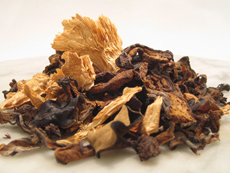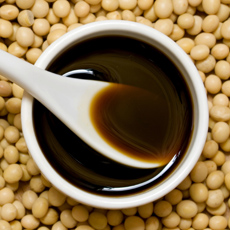TRENDS: Umami, The Fifth Taste
|
The weekend edition of The Wall Street Journal devoted a lot of space to an article called “A New Taste Sensation,” umami. However, this was news two years ago when Anna Kasabian and David Kasabian wrote their seminal book on the topic, The Fifth Taste: Cooking with Umami. It was the talk of gastronomy circles, and THE NIBBLE wrote a long article on umami. But, like sous vide and Gewürtztraminer, the concept didn’t trickle down to most fine food enthusiasts. It’s just a bit too east of mainstream. We have often thought about teaching a course on umami, because the fifth taste is not as easy to understand as the other four: sweet, salty, sour and bitter. Umami foods are characterized as having a high level of glutamate, an amino acid. MSG (monosodium glutamate), a manufactured form of natural glutamate. Glutamate adds flavor to food, just as sugar adds sweetness, salt adds saltiness and vinegar and lemon juice add tartness. All of these heighten the flavors of the foods they enhance. Yet, back to the argument: We can identify sweet, salty, bitter and sour. What does umami taste like? Somewhat like the flavors ascribed to a particular wine varietal, you have to taste and taste until you “get it.” We can name foods and dishes that contain umami flavor, but cannot point to any single, easily-recognizable flavor attribute. There is no umami equivalent of sweet, salty, sour/tart and bitter. According to the experts, here are some of the cornerstone products that showcase umami: anchovies, dried mushrooms, fish sauce (including Worcestershire sauce), ketchup, konbu*, MSG, Parmesan cheese and soy sauce. What do they have in common? This question takes us back to the beginning. |
 [1] For the best flavor, grate a wedge of Parmigiano-Reggiano as you need it. It’s cheesy, yes; but it’s also umami—brothy and savory (photo © Yin Yang | iStock Photo).
|
|
|
But try as we can, we still can’t match umami flavors to konbu and tomato until they are made into broth or other recipe—and then the commonality is the salt added to the recipe. Both are mild, even delicate in flavor until they join other ingredients. We might describe a vine-ripened tomato as sweet, or seaweed as briny/salty. But, umami claims them as well. None of this is addressed by The Wall Street Journal article or any other article we’ve read. The answer must be that umami double dips. It seems to us that every food that umami claims as its own can fall within one of the four existing classes, whereas sweet, salty, sour and better are completely discrete. For much of umami, we take it on faith, and that we’ll find the path sooner or later. And this is why umami, the fifth taste, has not “broken out” in the West. You can train people how to combine ingredients for heightened umami flavors, you can hand out umami-enriched recipes, you can print lists of umami-rich foods for people to memorize, but you can’t train them to identify them “umami taste.” *Konbu is a type of kelp, a large seaweed used to make dashi, a soup and cooking stock used in Japanese cuisines. Miso soup is made with dashi stock. |
||




